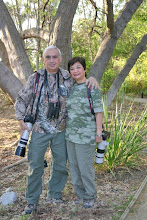Two more forest birds that also inhabit city parks are the Grey Butcherbird (Cracticus torquatus) and the Pied Currawong (Strepera graculina).
 |
| Grey Butcherbird |
 |
| Pied Currawong |
Grey Fantail (Rhipidura albiscapa)
Willie Wagtail (Rhipidura leucophyrs). The name is a bit confusing because it is not really a wagtail but actually a fantail. It is not known how the term "Willie" came about. Despite the vagueness of its name, it is a very active, friendly bird. The pair we saw in Lane cove were hunting for insects just a couple of feet away.
It is strange that we saw mostly the female and immature Australian Golden Whistlers (Pachycephala pectoralis). The more colorful male only appeared briefly and we only got a documentary shot of it.
 |
| male |
 |
| immature |
 |
| female |
Both male and female White-browed Scrubwrens (Sericornis frontalis) were a regular sighting for us.
 |
| male |
 |
| female |
The Silvereye (Zosterops lateralis) - a cousin of White-eyes - is just as active and very seldom stays put.
We got lucky when a pair of Spotted Pardalotes (Pardalotus punctatus) appeared. Most likely they have some young ones because both male and female were carrying food in the mouths and bringing it to their nest which was a hole in the ground.
 |
| female |
 |
| male |
Two species of Fairy Wrens were added to our lifelist:
The Superb Fairywren (Malurus cyaneus)
 |
| male |
 |
| female |
The Variegated Fairywren (Malurus lamberti)
 |
| male |
 |
| female |
The colorful Eastern Yellow Robin (Eopsaltria australis) was another active bird, always busy hawking for insects and worms (Note: no feeding or baiting done here).
Although it is just a "little brown bird" the Brown Gerygone (Gerygone mouki) was still a joy to see.
 |
The first of the four honeyeaters we encountered in Australia was the Yellow-faced Honeyeater (Lychenostomus crhysops).
|
Finally, a surprise! We learned later that this species was not very common and so it was such a blessing that we saw a Black-faced Monarch (Monarcha melanopsis)!










No comments:
Post a Comment